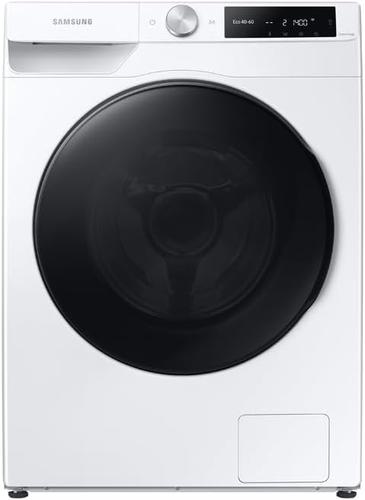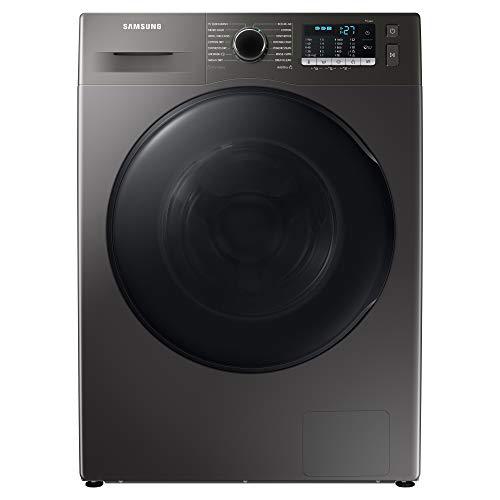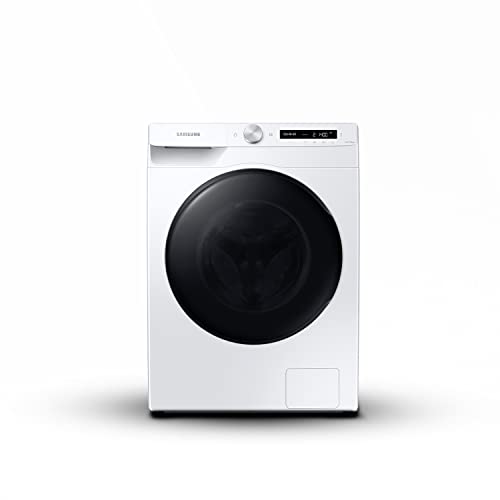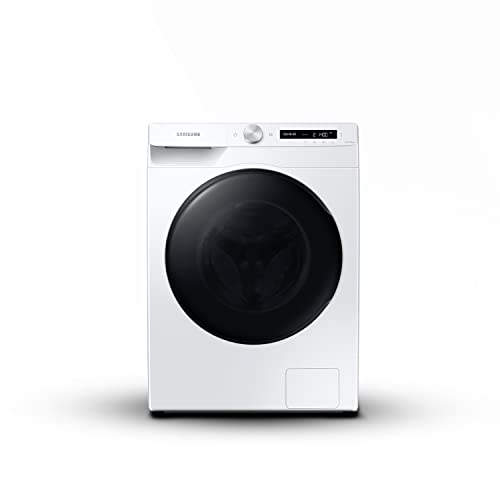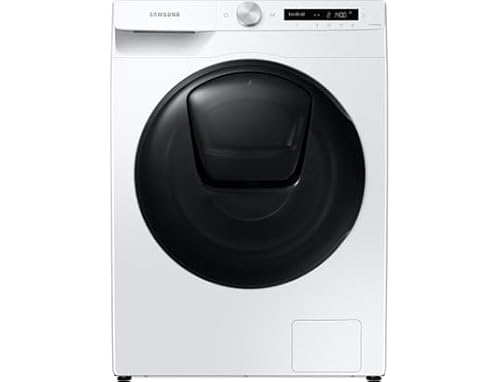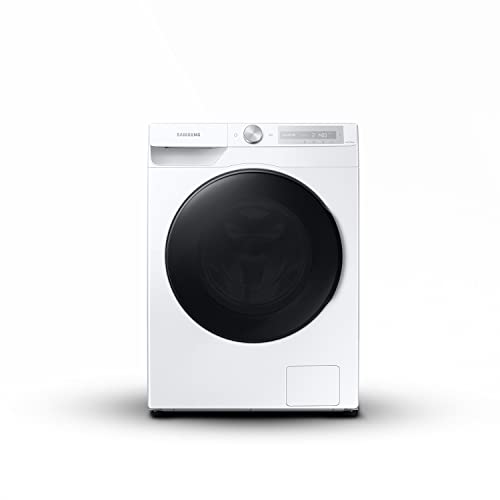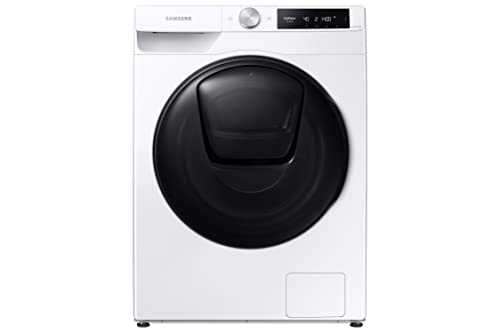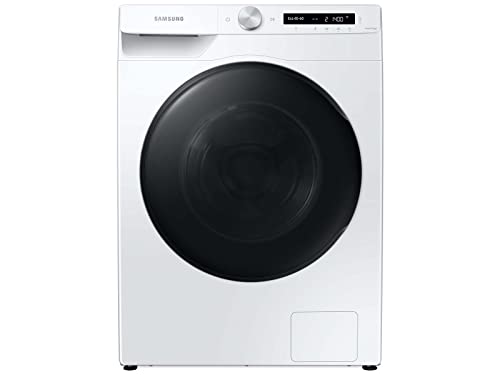Are Samsung washer-dryers good?
Samsung washer-dryers have an average overall score of 8 and rank at position #1 among all washer-dryer brands. Their average user rating is 8.4, and they hold the #2 spot among the top brands by user rating. 12 brands met the criteria (brands with fewer than 6 products in the database did not qualify).
The chart below ranks washer-dryer brands based on their overall scores.
[horizontal-chart-33878136557124569]
The best Samsung washer-dryers (with the highest overall score) are as follows.
- Samsung WD90DG6B85BEU1 Series 6 (Overall score: 8.67 points)
- Samsung Series 6 WD90T654DBN (Overall score: 8.37 points)
- Samsung Series 5 WD80TA046BX (Overall score: 7.39 points)
Note: Products currently available are listed first.
What are the main advantages of Samsung washer-dryers?
Samsung washer-dryers have the following advantages compared to other brands:
- Digital Inverter motor with extended warranty: All Samsung washer-dryers use a Digital Inverter motor and include a 20-year warranty.
- Higher maximum spin speed: All Samsung washer-dryers reach 1400 RPM, while the minimum is 400 RPM.
- More washing programs: Most Samsung washer-dryers include 22 washing programs (market average is 13 programs).
- Shorter ECO cycle duration: The combined ECO cycle in Samsung washer-dryers takes 465 minutes on average (20 minutes shorter than the market average of 485 minutes).
- Self-cleaning cycle: All Samsung washer-dryers include a dedicated Self-cleaning cycle.
- More wash functions: Many Samsung washer-dryers include Turbo+ function, Intensive option, Bubble Soak function, Rinse hold function, Extra rinse function and Prewash function.
- More built-in features: Samsung washer-dryers have an average of 23 features (market average is 15 features).
- Broader feature set in most models: Almost all Samsung washer-dryers include Pre-mix technology (Ecobubble), Automatic drawer cleaning (StayClean Drawer), Laundry detection system, Unbalanced load detection, Automatic drying, Delay Start option (up to 24 hours), Pause & Add option and Selectable drying level.
- Advanced technology options: Many Samsung models include the automatic dosing system (Ecodoser) and AI technology.
- Special drum for delicate clothes: All Samsung washer-dryers use a special drum for delicate textiles (BubbleCARE or Diamond Drum).
- Lower noise in spin phase: Samsung washer-dryers are on average 3 dB quieter during spinning (72 dB vs 75 dB market average) and all have a noise emission class A.
What are the main disadvantages of Samsung washer-dryers?
Samsung washer-dryers have the following disadvantages compared to the market average and other brands:
- Higher price: Samsung washer-dryers cost on average £160 more than the market average (£710 vs £550)
- Smaller drum volume: Samsung washer-dryers have on average 6 L less than the market average (54 L vs 60 L)
- No slim models: There are no slim Samsung washer-dryers available
- Higher washing energy consumption: Samsung washer-dryers use on average 57 kWh per 100 washing cycles, which is 2 kWh more than the market average of 55 kWh
- Higher combined energy consumption: Samsung washer-dryers use 377 kWh per 100 combined cycles, 59 kWh more than the market average of 318 kWh
- Higher water consumption per washing cycle: Samsung washer-dryers use 48 litres per cycle, while the market average is 50 litres
- Higher water consumption per combined cycle: Samsung washer-dryers use 90 litres per combined cycle, which is 11 litres more than the market average of 79 litres
- Missing wash programs: We have not found a Samsung washer-dryer with Jeans, Baby care or Duvet cycle
- Missing wash functions: We have found no Samsung washer-dryers with Water+ function or Soak function
- Missing support features: Samsung washer-dryers do not have foam control system, automatic load balancing during spin, Scan function or water jets system
- Missing convenience features: We have not found any Samsung washer-dryers with interior light, reversible door or any mention of antivibration design
Who makes Samsung washer-dryers?
Samsung Electronics Co., Ltd. manufactures its washer-dryers. The company, founded in 1969, is headquartered in Suwon, South Korea, and employs over 270,000 people globally . Its home appliance production spans multiple countries, including South Korea, China, Mexico, the United States, and India . In the U.S., Samsung operates a facility in Newberry County, South Carolina, where it began producing washing machines in 2018 . The company has considered relocating dryer production from its Querétaro, Mexico plant to this U.S. facility.
Samsung's global manufacturing network enables it to meet regional demands and adapt to market changes. For instance, in 2025, the company announced a $117 million investment in its Chennai, India facility, which produces washing machines, among other appliances . This expansion reflects Samsung's strategy to strengthen its presence in key markets and enhance its production capabilities.
What are the different series of Samsung washer-dryers?
Samsung washer-dryers come in the following series, each with specific features, capacities, and price ranges:
Series 4: You get key features like a laundry detection system, Digital Inverter motor, EcoBubble™ technology (mixes air, water, and detergent), Bubble Soak for tough stains like blood or grass, Hygiene Steam which releases steam from the drum bottom, Smart Check which lets you troubleshoot issues via smartphone, Drum Clean+ to remove dirt without harsh chemicals, Air Wash technology that uses hot air to deodorize and sanitize clothes, and a StayClean detergent drawer that flushes out leftover detergent. Models fall under D energy class, wash from 7 kg to 9 kg, dry 4 kg to 6 kg, run up to 12 programs, and usually cost £430 to £680.
Series 5: You get all features from Series 4 plus a better Extra Rinse option (up to 5 rinses depending on the cycle). Models reach B or C energy class, wash between 8 kg and 9 kg, dry 5 kg to 6 kg, include around 14 programs, and usually cost £680 to £1,100.
Series 5+: You gain everything from Series 5 and more. These models use AI Control which adapts to your habits, AI Energy Mode that cuts energy use up to 70%, Wi-Fi connectivity through SmartThings app, AutoDose in some models which sets detergent levels automatically, and the AddWash™ door which lets you insert forgotten laundry mid-cycle. They fall into A to C energy classes, support washing from 8 kg to 10.5 kg, drying from 5 kg to 6 kg, offer about 24 programs, and usually cost £510 to £1,230.
Series 6: Models expand on Series 5+ features. They include QuickDrive™ which completes a wash in 59 minutes and Eco Drum Cleaning+ that removes 99.9% of odor-causing bacteria and dirt from the drum and rubber seal. These machines fall under A to B energy class, wash from 9 kg to 10.5 kg, dry 6 kg, run about 24 programs, and usually cost £680 to £1,100.
Series 7: You see all features from Series 6 and improvements like Turbo+ which speeds up washing by using pre-mixed foam from air and detergent. Some models also include a Less Microfiber Cycle which reduces microfiber pollution in water. Machines reach A to B energy class, handle washing from 9 kg to 10.5 kg, drying 6 kg, include 24 programs, and cost around £680 to £1,280.
Series 9: You move to the highest tier. These models carry all Series 7 features and add OptimalDry™ which uses sensors to adjust drying time based on moisture and temperature. Models stay in A energy class, wash up to 9 kg, dry 6 kg, include 24 programs, and usually cost £1,280 to £1,870.

How much do Samsung washer-dryers cost?
Samsung washer-dryers usually cost from £430 up to £1,870, with an average price of around £710 (about £160 more than the market average which is £550). Samsung washer-dryers sit at position #(?) in the price classification (ordered from most expensive to cheapest) out of 12 brands.
The cheapest Samsung washer-dryers come from Series 4 and cost around £430 to £680. Series 5 and Series 6 models are more expensive and can go up to £1,100. The most expensive models are from Series 7 and Series 9 which reach £1,280 and £1,870 respectively.
Samsung washer-dryers have an average of (?) quality-price points and rank at position #(?) among 12 brands.
Samsung washer-dryer prices are presented in the following chart.
[vertical-chart-15322515503117425]
What should you consider while choosing the best Samsung tumble dryer?
When choosing the best Samsung tumble dryer, focus on washing and drying capacity, drum volume, dimensions, energy consumption, motor type, and available programs and features.
What is the most common type of Samsung washer-dryers?
The most common type of Samsung washer-dryers uses condensator technology for drying. You will usually find this type in most Samsung models.
What capacities are available for Samsung washer-dryers?
Samsung washer-dryers come with washing capacities that range from 7 to 12 kg and drying capacities from 4 to 8 kg. The most common washing-drying combinations are 9/6 kg (around 43%), 8/5 kg (around 33%) and 10.5/6 kg (around 14%).
Most models have a drum volume of 54 L, which is 6 L smaller than the market average of 60 L. Bigger capacity models can reach up to 67 L drum volume. You will not find slim Samsung washer-dryers, as their depth ranges from 55 to 65 cm. If you want a slim model, check other brands.
Samsung washer-dryers weigh between 66 and 80 kg, and the average is 68 kg, which matches the market average.
The capacity distribution for Samsung washer-dryers is illustrated in the chart below.
[pie-chart-19012018586418166]
How energy-efficient are Samsung washer-dryers?
Samsung washer-dryers are less energy-efficient than most other brands. For washing energy efficiency, Samsung models usually fall into classes A to D. About 27% of their models belong to class A, 32% to class B, 36% to class C, and 5% to class D. You won’t find any Samsung washer-dryers in class E. In comparison, 48% of washer-dryers in the overall market belong to class A, 19% to class B, 18% to class C, 12% to class D, and 3% to class E. So Samsung performs below average in this category.
Combined energy efficiency classes in Samsung washer-dryers range from D to F. About 5% belong to class D, 86% to class E, and 9% to class F. Samsung does not have any washer-dryers in class A, B, or C for combined energy efficiency. In the overall market, less than 1% of models belong to class A, 1% to class B, 1% to class C, 41% to class D, 49% to class E, and 4% to class F. This means Samsung ranks lower than most competitors here too.
Samsung washer-dryers usually consume between 44 and 69 kWh per 100 washing cycles, with an average of 57 kWh, which is higher than the market average of 55 kWh. For combined washing and drying cycles, energy use ranges from 326 to 487 kWh per 100 cycles, with an average of 377 kWh, which is also higher than the market average of 318 kWh.
Water consumption per washing cycle in Samsung washer-dryers ranges from 45 to 57 litres, with an average of 50 litres, higher than the market average of 48 litres. For combined cycles, water use ranges from 70 to 110 litres, with an average of 90 litres, again above the market average of 79 litres.
The following chart shows the distribution of washing energy efficiency classes across Samsung washer-dryers.
[pie-chart-29181728655322513]
What is the spin-drying efficiency of Samsung washer-dryers?
The spin-drying efficiency of Samsung washer-dryers usually falls under class B. This is slightly worse than the market average, where 14% of models belong to class A, 84% to class B, and less than 1% to class C. All Samsung washer-dryers reach a maximum spin speed of 1400 RPM, which places them solidly in the class B range. Spin-drying efficiency class strongly depends on maximum spin speed, so this explains their typical class B rating.
You can also select a minimum spin speed of 400 RPM on every Samsung washer-dryer, which helps if you often wash delicate clothes that need gentle treatment.
How loud are Samsung washer-dryers?
Samsung washer-dryers are quieter than most. Spin noise levels range from 72 to 73 dB, and most models have 72 dB, which is 3 dB lower than the market average of 75 dB. Washing noise levels range from 52 to 54 dB, and most have 54 dB, which matches the market average. Drying noise levels range from 59 to 62 dB, and most models have 59 dB, which also matches the market average.
All Samsung washer-dryers in the database belong to noise emission class A. This is better than the market average, where only 38% of models fall into class A. 31% belong to class B, 24% to class C, and 7% to class D.
Samsung washer-dryers rank at position #5 in the noise level classification (from lowest to highest) out of 12 brands.
How many washing & drying programs do Samsung washer-dryers offer?
Samsung washer-dryers have 10 to 23 washing programs (most have 22, which is a lot more than the market average) and 3 to 4 drying programs (similar to market average).
The most common Samsung washing programs are as follows:
- Cotton
- Eco 40-60
- 15' Quick Wash
- Intense Cold
- Wool
- Bedding
- Outdoor
- Shirts
- Towels
- Cloudy Day
- Activewear
- Colours
- Synthetics
- Delicates
- Mixed Load
- Hygiene Steam: By generating steam from the bottom of the drum, this hygienic programme treats the entire laundry. It eliminates 99.9% of allergy-causing bacteria** such as dust mites, pollen, animal hair etc.
- Air Wash: Air Wash technology refreshes and sanitises your clothes so they always smell fresh. It uses just warm air to control unpleasant odours and eliminates 99.9%* of bacteria without using water, detergent or chemicals.
The most common Samsung drying programs are as follows:
- Wash+Dry
- Cotton Dry
- Synthetics Dry
More advanced models include cycles such as:
- Silent Wash (in Series 5+ and above)
- Super Speed cycle (in some models of Series 6 and above) (Use Super Speed to wash a load in just 39 minutes*. QuickDrive™ moves clothes dynamically, and Ecobubble™ delivers powerful cleaning)
- Less Microfiber cycle (in selected models) (works to reduce shedding of microplastics, which enter drain water)
All Samsung washer-dryers have a self-cleaning cycle:
- Drum Clean (in Series 4 to 5+) (removes 99.9% of odour-causing bacteria from the drum without using aggressive or expensive detergents by combining soaking, pulsation and spin phase)
- Eco Drum Clean+ (in Series 6 to 9) (cleans the inside of the drum and removes 99.9% of bacteria that cause bad odours, without aggressive chemicals. A powerful water jet and fast spin also clean the rubber seal of the door)
You will not find Jeans, Baby Care or Duvet cycles in any Samsung washer-dryer model.
Washing ECO cycle lasts from 185 to 240 minutes, with 220 minutes being the average (same as market average). Combined ECO cycle (ECO cycle + cupboard drying level) lasts from 390 to 640 minutes, with 465 minutes being the average (20 minutes less than the market average of 485 minutes).
Which washing/drying functions do Samsung washer-dryers have?
Samsung washer-dryers have a wide range of washing and drying functions.
Some Samsung washer-dryers include also the following functions:
- Turbo+ function (only in models from serie 7): Washing time is reduced to up to 39 minutes. The detergent mixes with air bubbles in advance, which creates active foam that starts working from the first minute.
- Intensive option: For badly soiled laundry. The cycle runs longer than normal.
- Bubble Soak function: Helps remove many types of stubborn stains such as blood, tea, wine, make-up and grass. Clothes soak with active bubbles, so dirt and stains soften and remove more easily.
- Rinse hold function (in series 4 and 5)
- Extra Rinse function
- Prewash function
We have found none Samsung washer-dryers with Water+ function or Soak function, but these are very rare in general also in other brands.
What features do Samsung washer-dryers include?
Samsung washer-dryers include from 14 to 25 advanced features. Most have 23 features, which is 9 more than the market average of 14.
Almost all Samsung washer-dryers include the following features:
- Pre-mix technology (in 100% of Samsung models, while only in 38% of the overall market): Ecobubble™ technology injects air into the water and detergent mixture for more effective dissolution of detergents and the creation of high-performance foam, penetrating the fibres more quickly
- Automatic drawer cleaning (in 100% of Samsung models, while only in 13% of the overall market): StayClean Drawer powerful jet of water, following the one that brings the detergent into the drum, automatically removes any detergent or fabric softener residue from the detergent tray, leaving the drawer clean and sanitized
- Laundry detection system
- Unbalanced load detection
- Automatic drying
- Delay start option: for up to 24 hours
- Pause & Add option
- Selectable drying level
Following additional features appear in many Samsung models:
- Wi-Fi connectivity (in ~67% of Samsung models, while only in 31% of washer-dryers in the overall market): You can control cycles with the SmartThings app, start the cycle, receive notifications when the laundry is dry, view consumption statistics, use Laundry Recipe, My Cycles, eco indicator, smart diagnosis, power save mode (AI Energy Mode) and voice control
- Automatic dosing system (in ~38% of Samsung models): Ecodoser, thanks to an integrated system of sensors (Water, Weight and Detergent) calculates the quantity of detergent and fabric softener tailored for each load
- AI technology (in ~67% of Samsung models)
All Samsung washer-dryers also include:
- A special drum for delicate clothes (BubbleCARE or Diamond drum)
- Digital Inverter motor: Uses solid magnets that reach the desired results in a quieter and more effective way, and consumes less energy than a traditional motor
Samsung washer-dryers do not include foam control system, automatic load balancing during spin, scan function or water jets system. There is no mention of antivibration design, interior light or reversible door.



